Social Research Report: Statistical and Thematic Analysis Methods
VerifiedAdded on 2020/05/04
|12
|2909
|29
Report
AI Summary
This report provides an overview of statistical and thematic analysis methods used in social research. It begins with a brief overview of each method, followed by a detailed discussion of their strengths and weaknesses, particularly in the context of researching the impact of alcohol use on postgraduate student academic performance. The report then explores the descriptive, reflective, and critical components of both methods. The statistical analysis section emphasizes the use of tools like SPSS and regression analysis, highlighting the accuracy of data and the potential for immediate feedback. Thematic analysis is examined for its reliance on the opinions of scholars and secondary data sources. The descriptive components focus on presenting data features, while the reflective components encourage self-evaluation after analysis. Critical components involve incorporating the views of various scholars to provide a comprehensive understanding. The report provides a comparative analysis of these methods, their applications, and limitations.
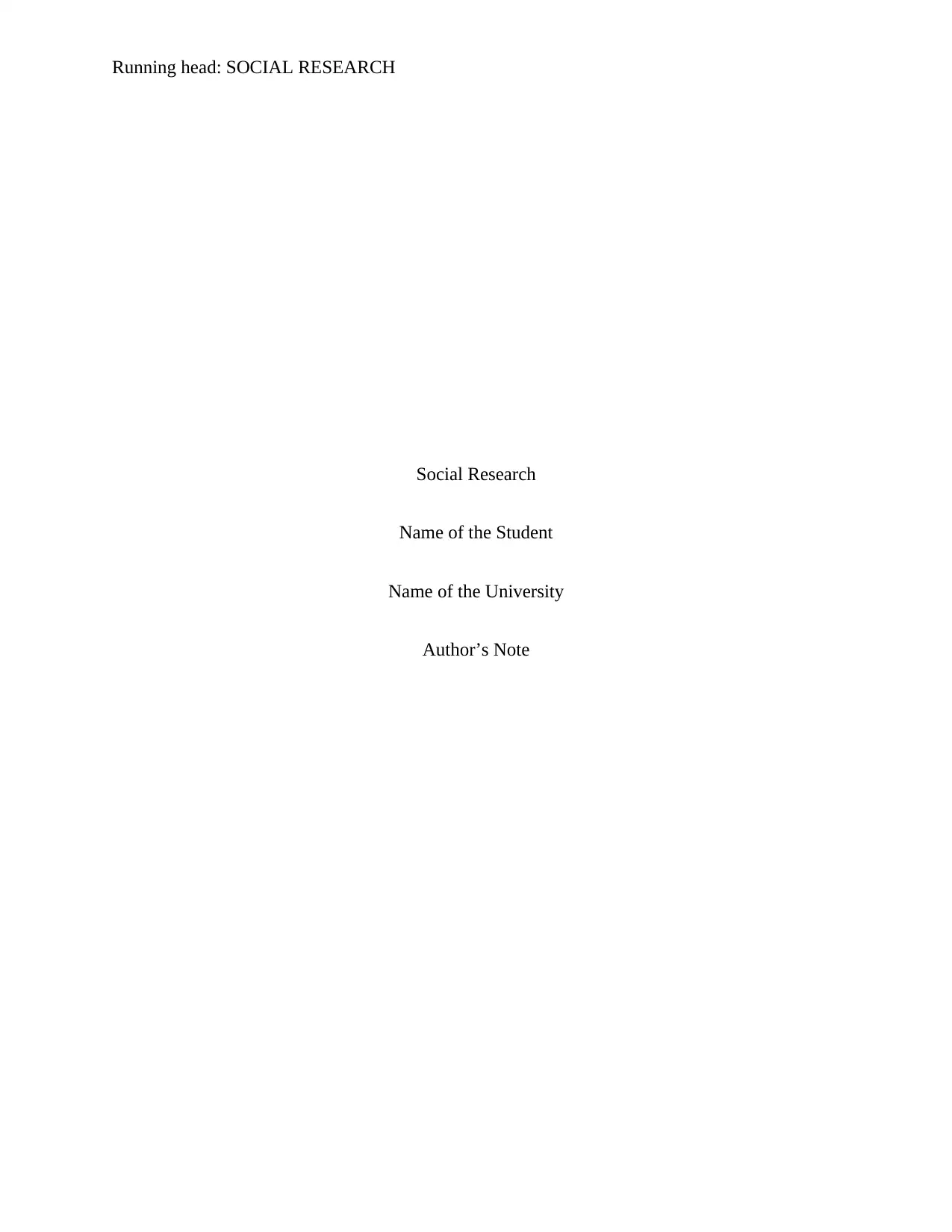
Running head: SOCIAL RESEARCH
Social Research
Name of the Student
Name of the University
Author’s Note
Social Research
Name of the Student
Name of the University
Author’s Note
Paraphrase This Document
Need a fresh take? Get an instant paraphrase of this document with our AI Paraphraser
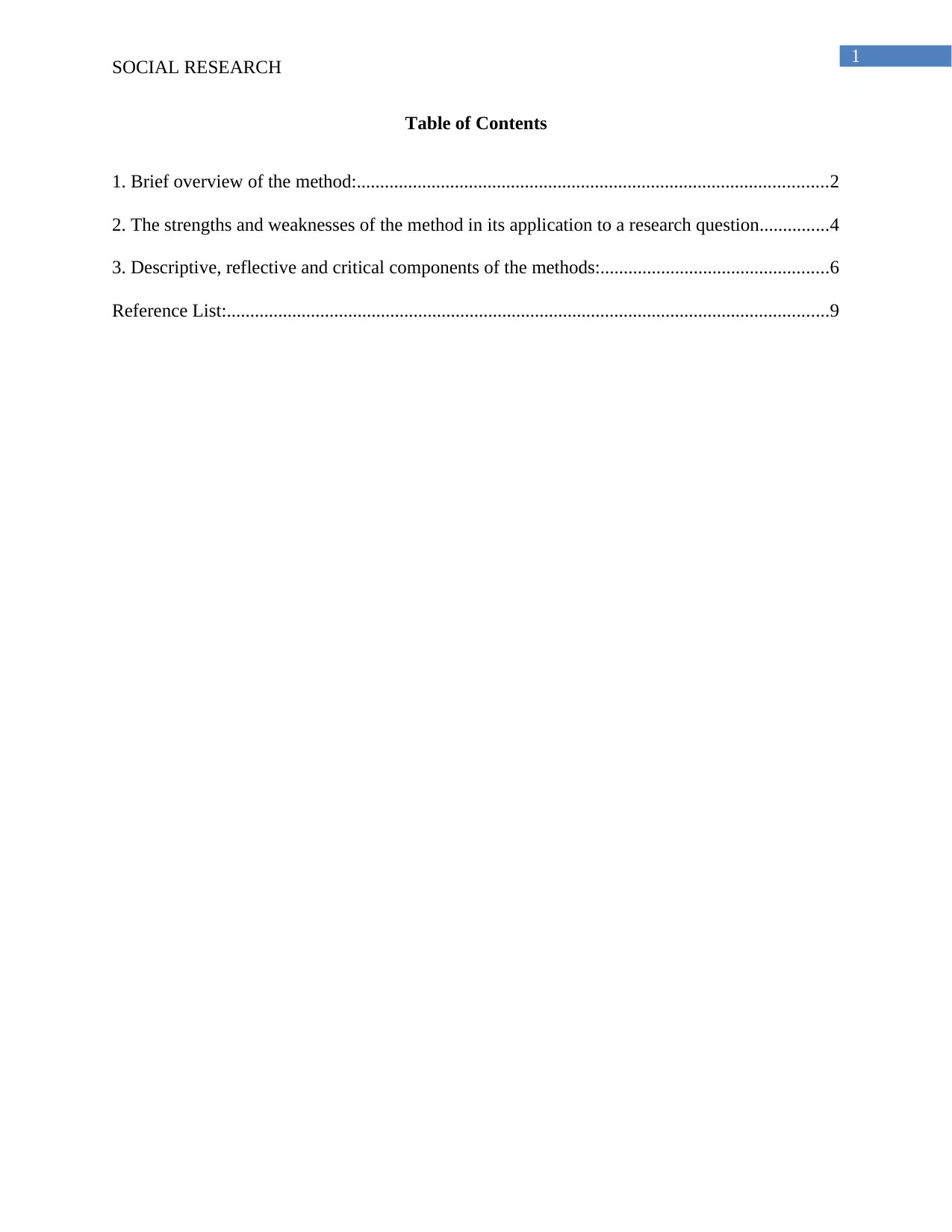
1
SOCIAL RESEARCH
Table of Contents
1. Brief overview of the method:.....................................................................................................2
2. The strengths and weaknesses of the method in its application to a research question...............4
3. Descriptive, reflective and critical components of the methods:.................................................6
Reference List:.................................................................................................................................9
SOCIAL RESEARCH
Table of Contents
1. Brief overview of the method:.....................................................................................................2
2. The strengths and weaknesses of the method in its application to a research question...............4
3. Descriptive, reflective and critical components of the methods:.................................................6
Reference List:.................................................................................................................................9
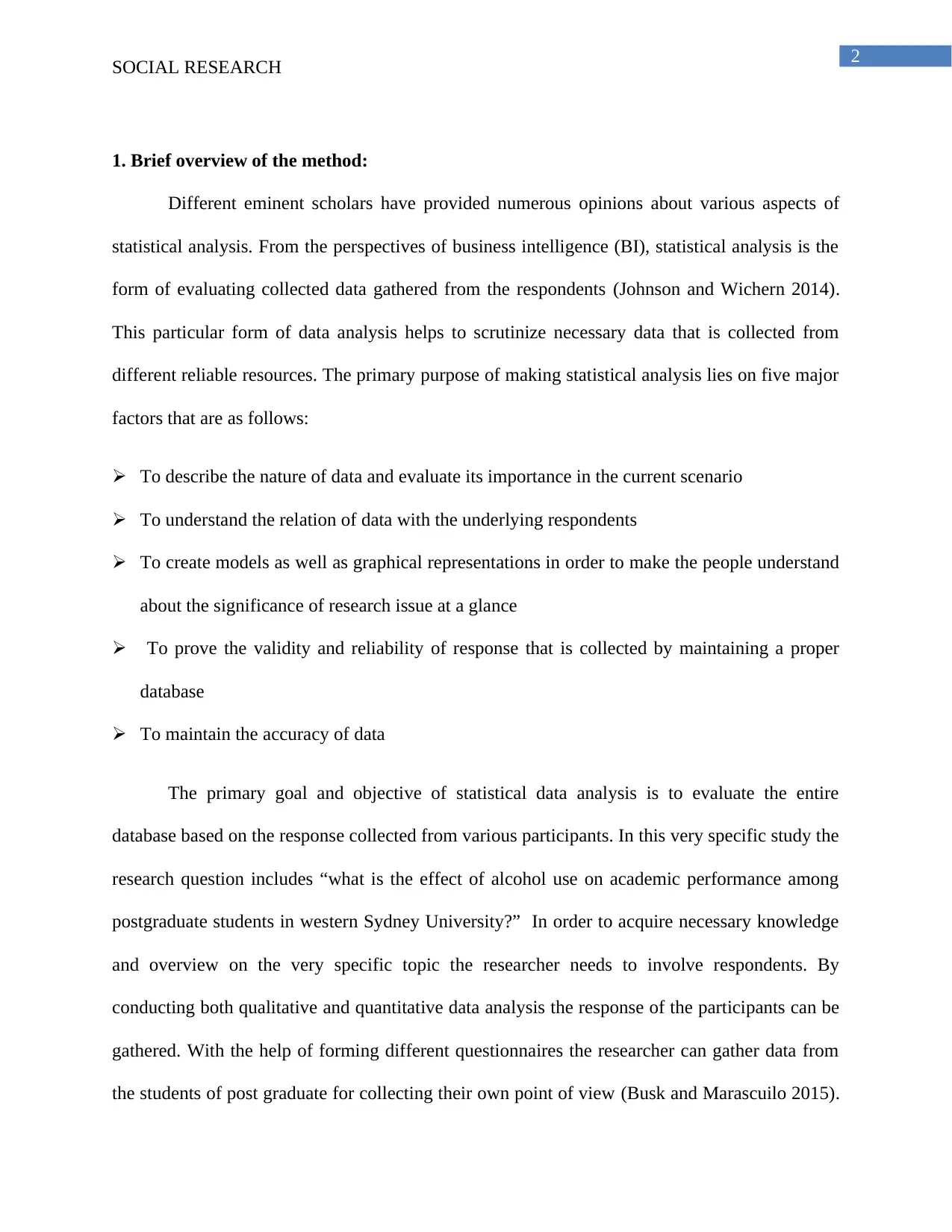
2
SOCIAL RESEARCH
1. Brief overview of the method:
Different eminent scholars have provided numerous opinions about various aspects of
statistical analysis. From the perspectives of business intelligence (BI), statistical analysis is the
form of evaluating collected data gathered from the respondents (Johnson and Wichern 2014).
This particular form of data analysis helps to scrutinize necessary data that is collected from
different reliable resources. The primary purpose of making statistical analysis lies on five major
factors that are as follows:
To describe the nature of data and evaluate its importance in the current scenario
To understand the relation of data with the underlying respondents
To create models as well as graphical representations in order to make the people understand
about the significance of research issue at a glance
To prove the validity and reliability of response that is collected by maintaining a proper
database
To maintain the accuracy of data
The primary goal and objective of statistical data analysis is to evaluate the entire
database based on the response collected from various participants. In this very specific study the
research question includes “what is the effect of alcohol use on academic performance among
postgraduate students in western Sydney University?” In order to acquire necessary knowledge
and overview on the very specific topic the researcher needs to involve respondents. By
conducting both qualitative and quantitative data analysis the response of the participants can be
gathered. With the help of forming different questionnaires the researcher can gather data from
the students of post graduate for collecting their own point of view (Busk and Marascuilo 2015).
SOCIAL RESEARCH
1. Brief overview of the method:
Different eminent scholars have provided numerous opinions about various aspects of
statistical analysis. From the perspectives of business intelligence (BI), statistical analysis is the
form of evaluating collected data gathered from the respondents (Johnson and Wichern 2014).
This particular form of data analysis helps to scrutinize necessary data that is collected from
different reliable resources. The primary purpose of making statistical analysis lies on five major
factors that are as follows:
To describe the nature of data and evaluate its importance in the current scenario
To understand the relation of data with the underlying respondents
To create models as well as graphical representations in order to make the people understand
about the significance of research issue at a glance
To prove the validity and reliability of response that is collected by maintaining a proper
database
To maintain the accuracy of data
The primary goal and objective of statistical data analysis is to evaluate the entire
database based on the response collected from various participants. In this very specific study the
research question includes “what is the effect of alcohol use on academic performance among
postgraduate students in western Sydney University?” In order to acquire necessary knowledge
and overview on the very specific topic the researcher needs to involve respondents. By
conducting both qualitative and quantitative data analysis the response of the participants can be
gathered. With the help of forming different questionnaires the researcher can gather data from
the students of post graduate for collecting their own point of view (Busk and Marascuilo 2015).
⊘ This is a preview!⊘
Do you want full access?
Subscribe today to unlock all pages.

Trusted by 1+ million students worldwide
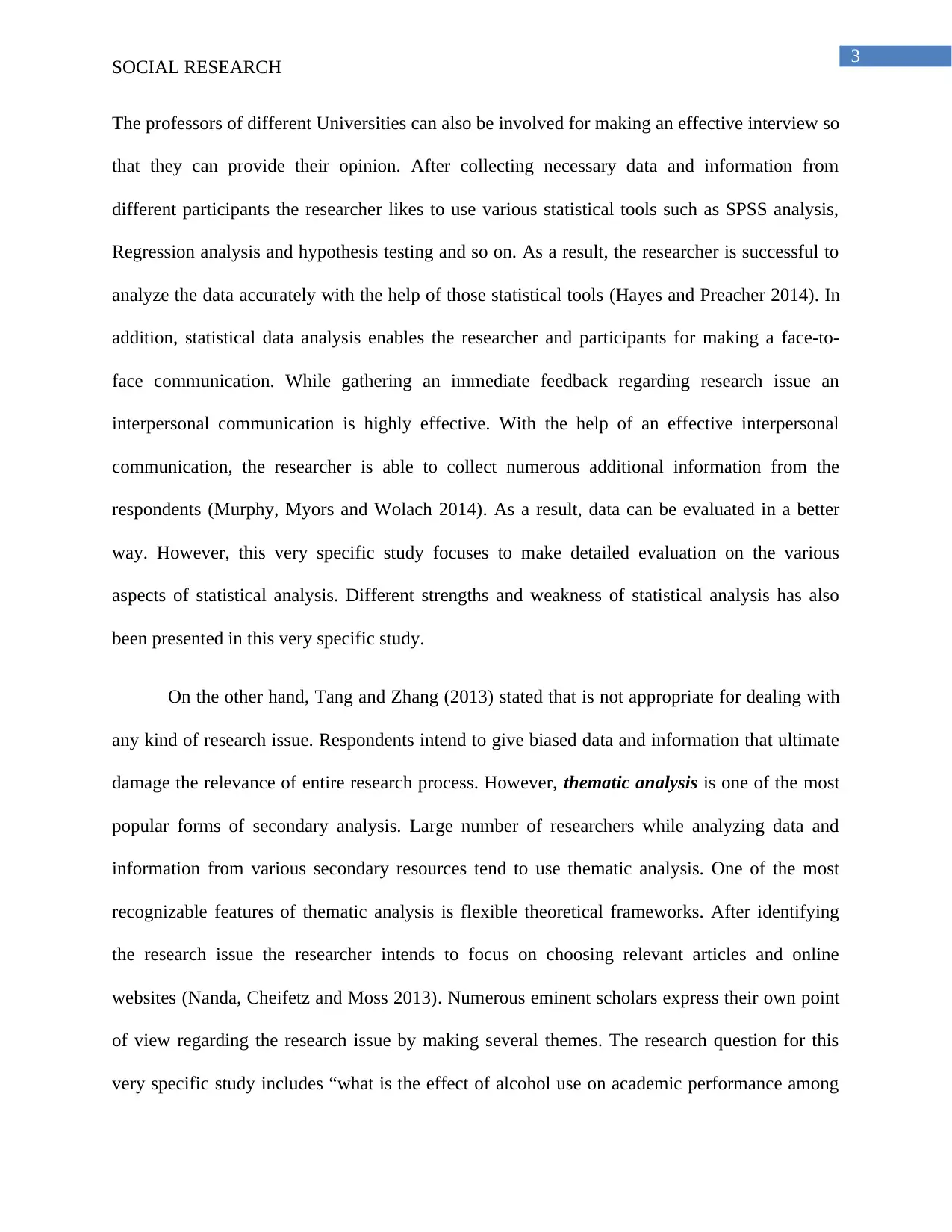
3
SOCIAL RESEARCH
The professors of different Universities can also be involved for making an effective interview so
that they can provide their opinion. After collecting necessary data and information from
different participants the researcher likes to use various statistical tools such as SPSS analysis,
Regression analysis and hypothesis testing and so on. As a result, the researcher is successful to
analyze the data accurately with the help of those statistical tools (Hayes and Preacher 2014). In
addition, statistical data analysis enables the researcher and participants for making a face-to-
face communication. While gathering an immediate feedback regarding research issue an
interpersonal communication is highly effective. With the help of an effective interpersonal
communication, the researcher is able to collect numerous additional information from the
respondents (Murphy, Myors and Wolach 2014). As a result, data can be evaluated in a better
way. However, this very specific study focuses to make detailed evaluation on the various
aspects of statistical analysis. Different strengths and weakness of statistical analysis has also
been presented in this very specific study.
On the other hand, Tang and Zhang (2013) stated that is not appropriate for dealing with
any kind of research issue. Respondents intend to give biased data and information that ultimate
damage the relevance of entire research process. However, thematic analysis is one of the most
popular forms of secondary analysis. Large number of researchers while analyzing data and
information from various secondary resources tend to use thematic analysis. One of the most
recognizable features of thematic analysis is flexible theoretical frameworks. After identifying
the research issue the researcher intends to focus on choosing relevant articles and online
websites (Nanda, Cheifetz and Moss 2013). Numerous eminent scholars express their own point
of view regarding the research issue by making several themes. The research question for this
very specific study includes “what is the effect of alcohol use on academic performance among
SOCIAL RESEARCH
The professors of different Universities can also be involved for making an effective interview so
that they can provide their opinion. After collecting necessary data and information from
different participants the researcher likes to use various statistical tools such as SPSS analysis,
Regression analysis and hypothesis testing and so on. As a result, the researcher is successful to
analyze the data accurately with the help of those statistical tools (Hayes and Preacher 2014). In
addition, statistical data analysis enables the researcher and participants for making a face-to-
face communication. While gathering an immediate feedback regarding research issue an
interpersonal communication is highly effective. With the help of an effective interpersonal
communication, the researcher is able to collect numerous additional information from the
respondents (Murphy, Myors and Wolach 2014). As a result, data can be evaluated in a better
way. However, this very specific study focuses to make detailed evaluation on the various
aspects of statistical analysis. Different strengths and weakness of statistical analysis has also
been presented in this very specific study.
On the other hand, Tang and Zhang (2013) stated that is not appropriate for dealing with
any kind of research issue. Respondents intend to give biased data and information that ultimate
damage the relevance of entire research process. However, thematic analysis is one of the most
popular forms of secondary analysis. Large number of researchers while analyzing data and
information from various secondary resources tend to use thematic analysis. One of the most
recognizable features of thematic analysis is flexible theoretical frameworks. After identifying
the research issue the researcher intends to focus on choosing relevant articles and online
websites (Nanda, Cheifetz and Moss 2013). Numerous eminent scholars express their own point
of view regarding the research issue by making several themes. The research question for this
very specific study includes “what is the effect of alcohol use on academic performance among
Paraphrase This Document
Need a fresh take? Get an instant paraphrase of this document with our AI Paraphraser
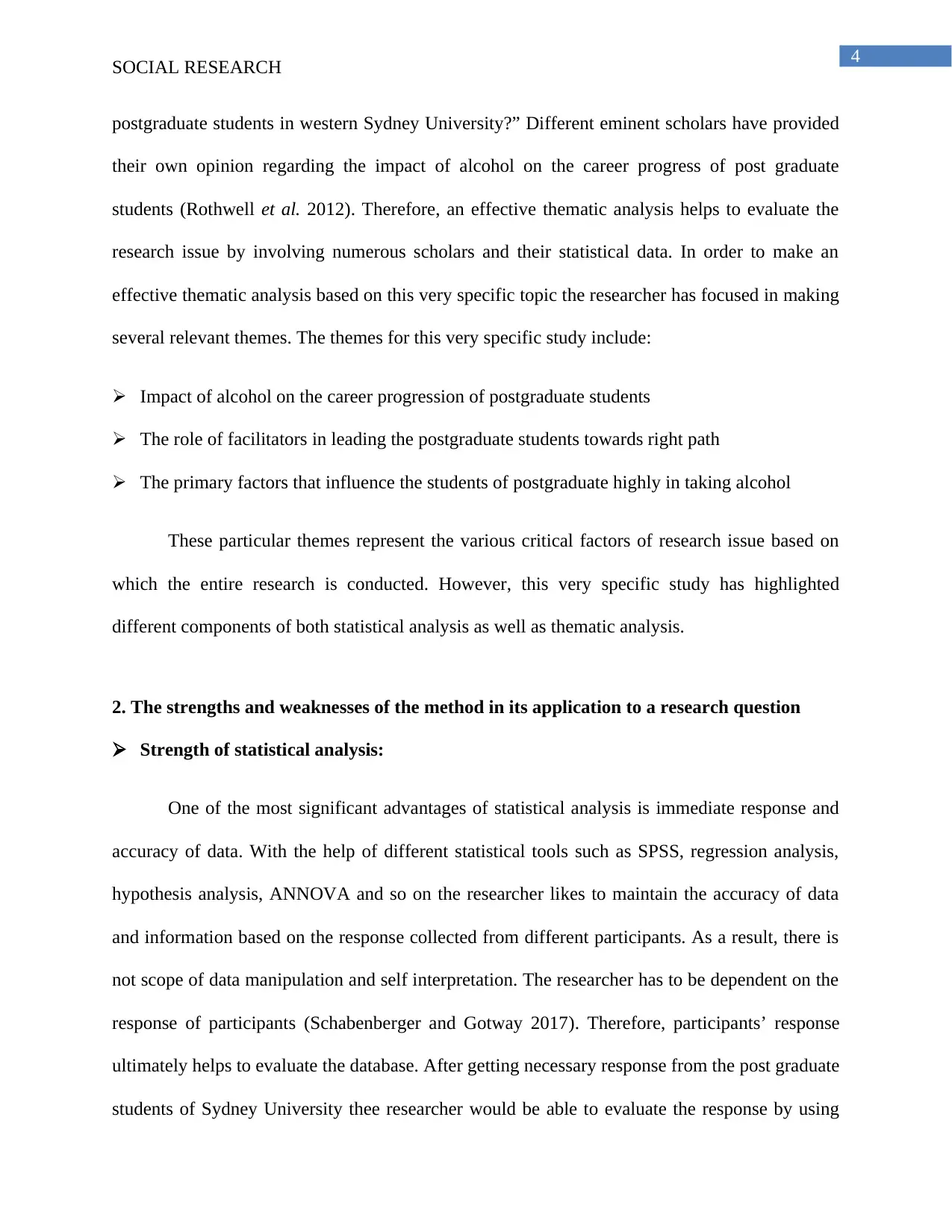
4
SOCIAL RESEARCH
postgraduate students in western Sydney University?” Different eminent scholars have provided
their own opinion regarding the impact of alcohol on the career progress of post graduate
students (Rothwell et al. 2012). Therefore, an effective thematic analysis helps to evaluate the
research issue by involving numerous scholars and their statistical data. In order to make an
effective thematic analysis based on this very specific topic the researcher has focused in making
several relevant themes. The themes for this very specific study include:
Impact of alcohol on the career progression of postgraduate students
The role of facilitators in leading the postgraduate students towards right path
The primary factors that influence the students of postgraduate highly in taking alcohol
These particular themes represent the various critical factors of research issue based on
which the entire research is conducted. However, this very specific study has highlighted
different components of both statistical analysis as well as thematic analysis.
2. The strengths and weaknesses of the method in its application to a research question
Strength of statistical analysis:
One of the most significant advantages of statistical analysis is immediate response and
accuracy of data. With the help of different statistical tools such as SPSS, regression analysis,
hypothesis analysis, ANNOVA and so on the researcher likes to maintain the accuracy of data
and information based on the response collected from different participants. As a result, there is
not scope of data manipulation and self interpretation. The researcher has to be dependent on the
response of participants (Schabenberger and Gotway 2017). Therefore, participants’ response
ultimately helps to evaluate the database. After getting necessary response from the post graduate
students of Sydney University thee researcher would be able to evaluate the response by using
SOCIAL RESEARCH
postgraduate students in western Sydney University?” Different eminent scholars have provided
their own opinion regarding the impact of alcohol on the career progress of post graduate
students (Rothwell et al. 2012). Therefore, an effective thematic analysis helps to evaluate the
research issue by involving numerous scholars and their statistical data. In order to make an
effective thematic analysis based on this very specific topic the researcher has focused in making
several relevant themes. The themes for this very specific study include:
Impact of alcohol on the career progression of postgraduate students
The role of facilitators in leading the postgraduate students towards right path
The primary factors that influence the students of postgraduate highly in taking alcohol
These particular themes represent the various critical factors of research issue based on
which the entire research is conducted. However, this very specific study has highlighted
different components of both statistical analysis as well as thematic analysis.
2. The strengths and weaknesses of the method in its application to a research question
Strength of statistical analysis:
One of the most significant advantages of statistical analysis is immediate response and
accuracy of data. With the help of different statistical tools such as SPSS, regression analysis,
hypothesis analysis, ANNOVA and so on the researcher likes to maintain the accuracy of data
and information based on the response collected from different participants. As a result, there is
not scope of data manipulation and self interpretation. The researcher has to be dependent on the
response of participants (Schabenberger and Gotway 2017). Therefore, participants’ response
ultimately helps to evaluate the database. After getting necessary response from the post graduate
students of Sydney University thee researcher would be able to evaluate the response by using
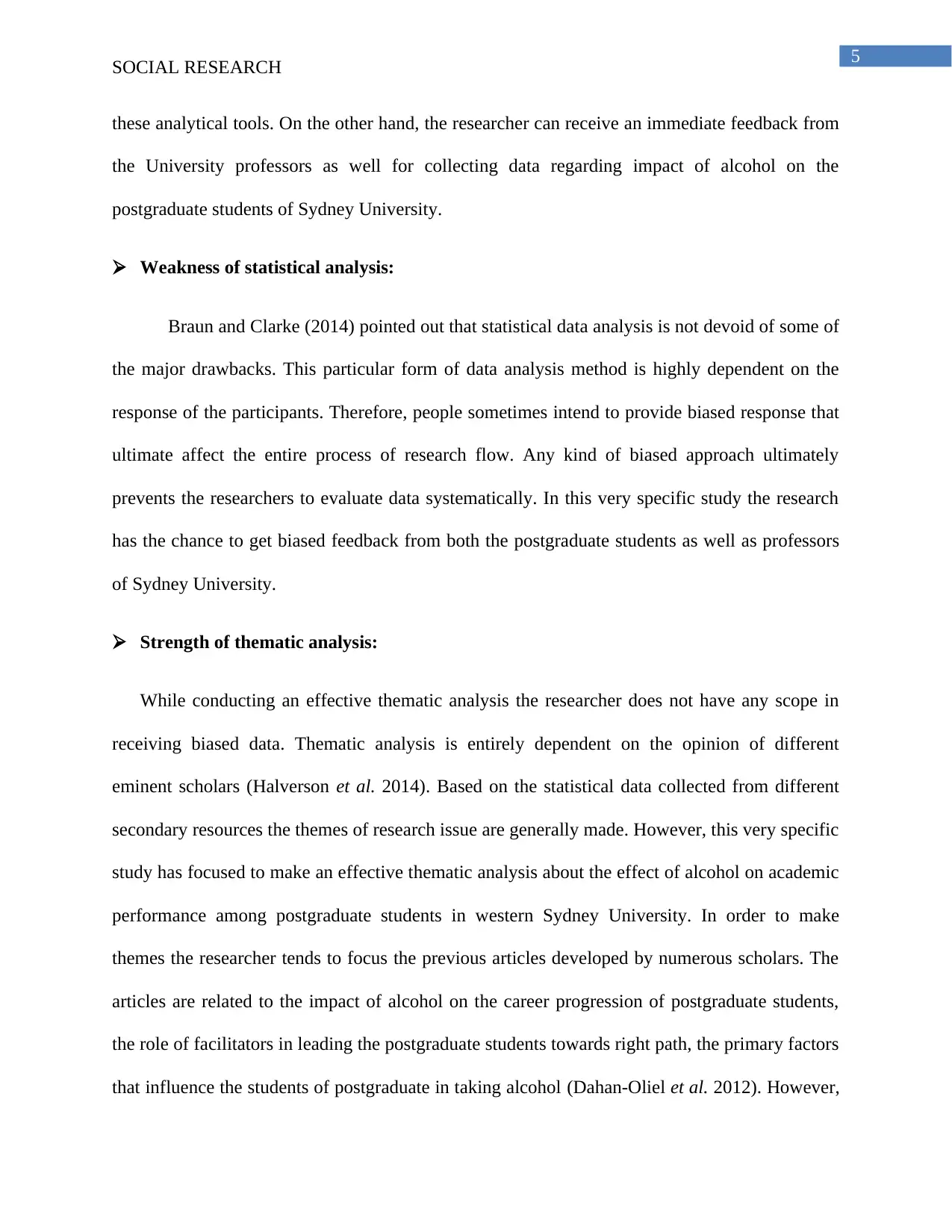
5
SOCIAL RESEARCH
these analytical tools. On the other hand, the researcher can receive an immediate feedback from
the University professors as well for collecting data regarding impact of alcohol on the
postgraduate students of Sydney University.
Weakness of statistical analysis:
Braun and Clarke (2014) pointed out that statistical data analysis is not devoid of some of
the major drawbacks. This particular form of data analysis method is highly dependent on the
response of the participants. Therefore, people sometimes intend to provide biased response that
ultimate affect the entire process of research flow. Any kind of biased approach ultimately
prevents the researchers to evaluate data systematically. In this very specific study the research
has the chance to get biased feedback from both the postgraduate students as well as professors
of Sydney University.
Strength of thematic analysis:
While conducting an effective thematic analysis the researcher does not have any scope in
receiving biased data. Thematic analysis is entirely dependent on the opinion of different
eminent scholars (Halverson et al. 2014). Based on the statistical data collected from different
secondary resources the themes of research issue are generally made. However, this very specific
study has focused to make an effective thematic analysis about the effect of alcohol on academic
performance among postgraduate students in western Sydney University. In order to make
themes the researcher tends to focus the previous articles developed by numerous scholars. The
articles are related to the impact of alcohol on the career progression of postgraduate students,
the role of facilitators in leading the postgraduate students towards right path, the primary factors
that influence the students of postgraduate in taking alcohol (Dahan-Oliel et al. 2012). However,
SOCIAL RESEARCH
these analytical tools. On the other hand, the researcher can receive an immediate feedback from
the University professors as well for collecting data regarding impact of alcohol on the
postgraduate students of Sydney University.
Weakness of statistical analysis:
Braun and Clarke (2014) pointed out that statistical data analysis is not devoid of some of
the major drawbacks. This particular form of data analysis method is highly dependent on the
response of the participants. Therefore, people sometimes intend to provide biased response that
ultimate affect the entire process of research flow. Any kind of biased approach ultimately
prevents the researchers to evaluate data systematically. In this very specific study the research
has the chance to get biased feedback from both the postgraduate students as well as professors
of Sydney University.
Strength of thematic analysis:
While conducting an effective thematic analysis the researcher does not have any scope in
receiving biased data. Thematic analysis is entirely dependent on the opinion of different
eminent scholars (Halverson et al. 2014). Based on the statistical data collected from different
secondary resources the themes of research issue are generally made. However, this very specific
study has focused to make an effective thematic analysis about the effect of alcohol on academic
performance among postgraduate students in western Sydney University. In order to make
themes the researcher tends to focus the previous articles developed by numerous scholars. The
articles are related to the impact of alcohol on the career progression of postgraduate students,
the role of facilitators in leading the postgraduate students towards right path, the primary factors
that influence the students of postgraduate in taking alcohol (Dahan-Oliel et al. 2012). However,
⊘ This is a preview!⊘
Do you want full access?
Subscribe today to unlock all pages.

Trusted by 1+ million students worldwide
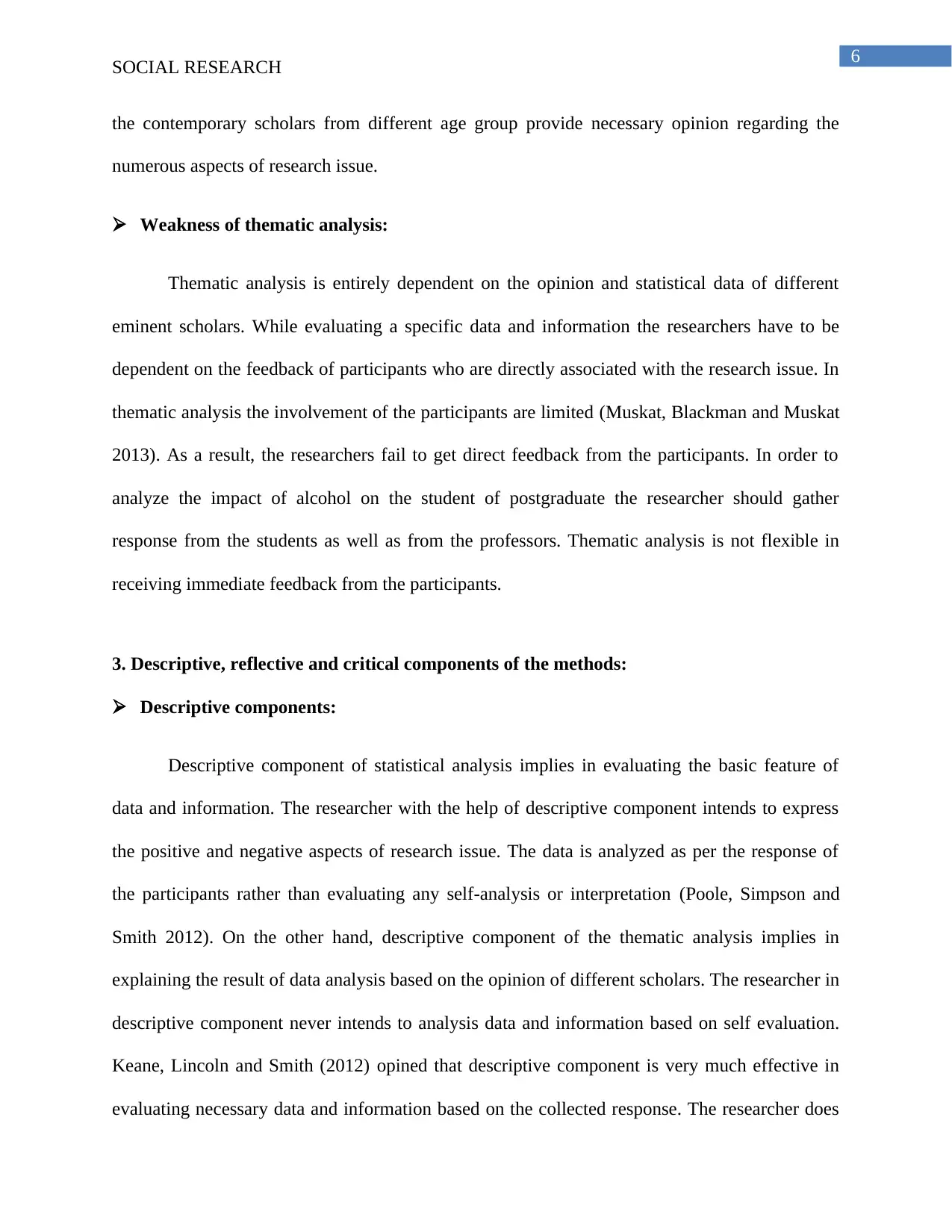
6
SOCIAL RESEARCH
the contemporary scholars from different age group provide necessary opinion regarding the
numerous aspects of research issue.
Weakness of thematic analysis:
Thematic analysis is entirely dependent on the opinion and statistical data of different
eminent scholars. While evaluating a specific data and information the researchers have to be
dependent on the feedback of participants who are directly associated with the research issue. In
thematic analysis the involvement of the participants are limited (Muskat, Blackman and Muskat
2013). As a result, the researchers fail to get direct feedback from the participants. In order to
analyze the impact of alcohol on the student of postgraduate the researcher should gather
response from the students as well as from the professors. Thematic analysis is not flexible in
receiving immediate feedback from the participants.
3. Descriptive, reflective and critical components of the methods:
Descriptive components:
Descriptive component of statistical analysis implies in evaluating the basic feature of
data and information. The researcher with the help of descriptive component intends to express
the positive and negative aspects of research issue. The data is analyzed as per the response of
the participants rather than evaluating any self-analysis or interpretation (Poole, Simpson and
Smith 2012). On the other hand, descriptive component of the thematic analysis implies in
explaining the result of data analysis based on the opinion of different scholars. The researcher in
descriptive component never intends to analysis data and information based on self evaluation.
Keane, Lincoln and Smith (2012) opined that descriptive component is very much effective in
evaluating necessary data and information based on the collected response. The researcher does
SOCIAL RESEARCH
the contemporary scholars from different age group provide necessary opinion regarding the
numerous aspects of research issue.
Weakness of thematic analysis:
Thematic analysis is entirely dependent on the opinion and statistical data of different
eminent scholars. While evaluating a specific data and information the researchers have to be
dependent on the feedback of participants who are directly associated with the research issue. In
thematic analysis the involvement of the participants are limited (Muskat, Blackman and Muskat
2013). As a result, the researchers fail to get direct feedback from the participants. In order to
analyze the impact of alcohol on the student of postgraduate the researcher should gather
response from the students as well as from the professors. Thematic analysis is not flexible in
receiving immediate feedback from the participants.
3. Descriptive, reflective and critical components of the methods:
Descriptive components:
Descriptive component of statistical analysis implies in evaluating the basic feature of
data and information. The researcher with the help of descriptive component intends to express
the positive and negative aspects of research issue. The data is analyzed as per the response of
the participants rather than evaluating any self-analysis or interpretation (Poole, Simpson and
Smith 2012). On the other hand, descriptive component of the thematic analysis implies in
explaining the result of data analysis based on the opinion of different scholars. The researcher in
descriptive component never intends to analysis data and information based on self evaluation.
Keane, Lincoln and Smith (2012) opined that descriptive component is very much effective in
evaluating necessary data and information based on the collected response. The researcher does
Paraphrase This Document
Need a fresh take? Get an instant paraphrase of this document with our AI Paraphraser
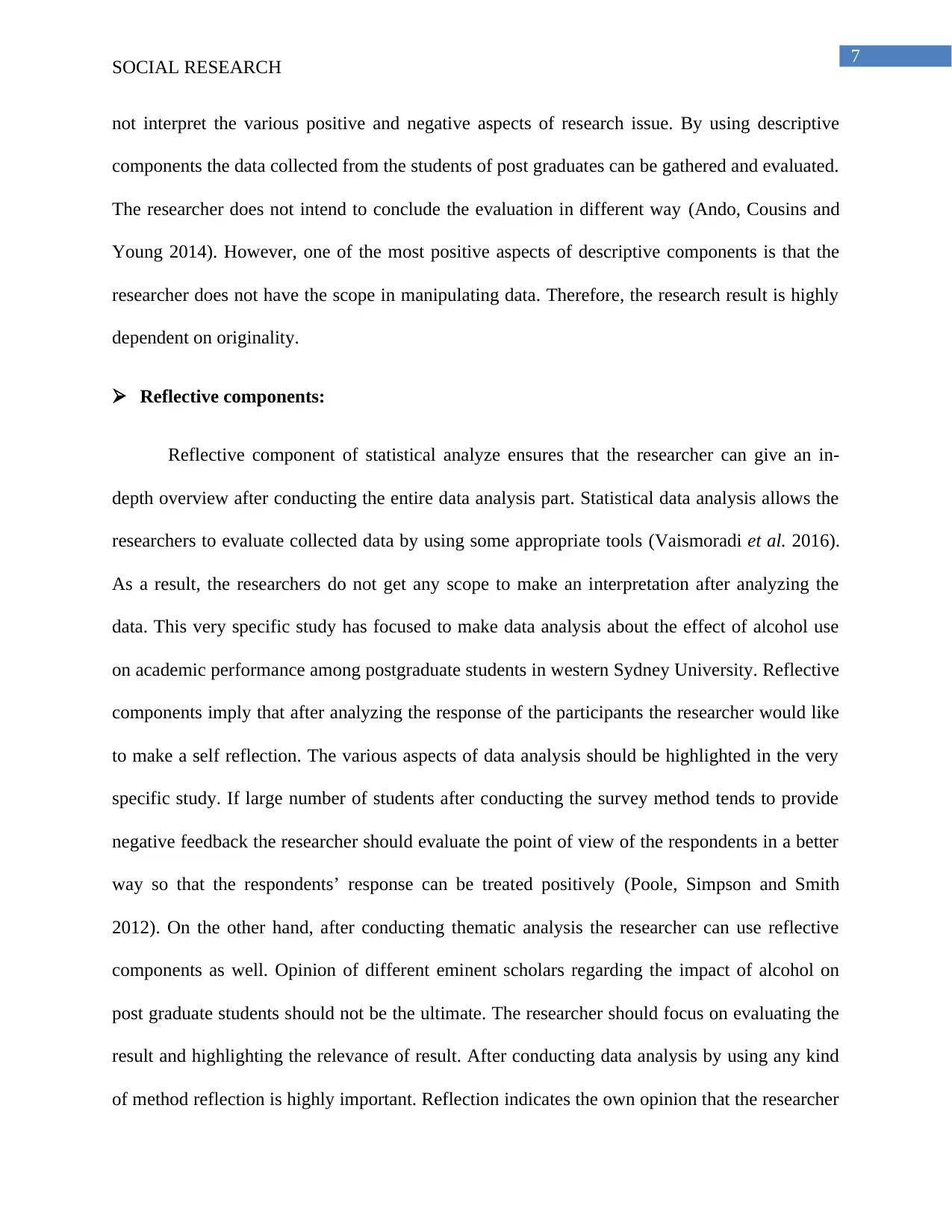
7
SOCIAL RESEARCH
not interpret the various positive and negative aspects of research issue. By using descriptive
components the data collected from the students of post graduates can be gathered and evaluated.
The researcher does not intend to conclude the evaluation in different way (Ando, Cousins and
Young 2014). However, one of the most positive aspects of descriptive components is that the
researcher does not have the scope in manipulating data. Therefore, the research result is highly
dependent on originality.
Reflective components:
Reflective component of statistical analyze ensures that the researcher can give an in-
depth overview after conducting the entire data analysis part. Statistical data analysis allows the
researchers to evaluate collected data by using some appropriate tools (Vaismoradi et al. 2016).
As a result, the researchers do not get any scope to make an interpretation after analyzing the
data. This very specific study has focused to make data analysis about the effect of alcohol use
on academic performance among postgraduate students in western Sydney University. Reflective
components imply that after analyzing the response of the participants the researcher would like
to make a self reflection. The various aspects of data analysis should be highlighted in the very
specific study. If large number of students after conducting the survey method tends to provide
negative feedback the researcher should evaluate the point of view of the respondents in a better
way so that the respondents’ response can be treated positively (Poole, Simpson and Smith
2012). On the other hand, after conducting thematic analysis the researcher can use reflective
components as well. Opinion of different eminent scholars regarding the impact of alcohol on
post graduate students should not be the ultimate. The researcher should focus on evaluating the
result and highlighting the relevance of result. After conducting data analysis by using any kind
of method reflection is highly important. Reflection indicates the own opinion that the researcher
SOCIAL RESEARCH
not interpret the various positive and negative aspects of research issue. By using descriptive
components the data collected from the students of post graduates can be gathered and evaluated.
The researcher does not intend to conclude the evaluation in different way (Ando, Cousins and
Young 2014). However, one of the most positive aspects of descriptive components is that the
researcher does not have the scope in manipulating data. Therefore, the research result is highly
dependent on originality.
Reflective components:
Reflective component of statistical analyze ensures that the researcher can give an in-
depth overview after conducting the entire data analysis part. Statistical data analysis allows the
researchers to evaluate collected data by using some appropriate tools (Vaismoradi et al. 2016).
As a result, the researchers do not get any scope to make an interpretation after analyzing the
data. This very specific study has focused to make data analysis about the effect of alcohol use
on academic performance among postgraduate students in western Sydney University. Reflective
components imply that after analyzing the response of the participants the researcher would like
to make a self reflection. The various aspects of data analysis should be highlighted in the very
specific study. If large number of students after conducting the survey method tends to provide
negative feedback the researcher should evaluate the point of view of the respondents in a better
way so that the respondents’ response can be treated positively (Poole, Simpson and Smith
2012). On the other hand, after conducting thematic analysis the researcher can use reflective
components as well. Opinion of different eminent scholars regarding the impact of alcohol on
post graduate students should not be the ultimate. The researcher should focus on evaluating the
result and highlighting the relevance of result. After conducting data analysis by using any kind
of method reflection is highly important. Reflection indicates the own opinion that the researcher
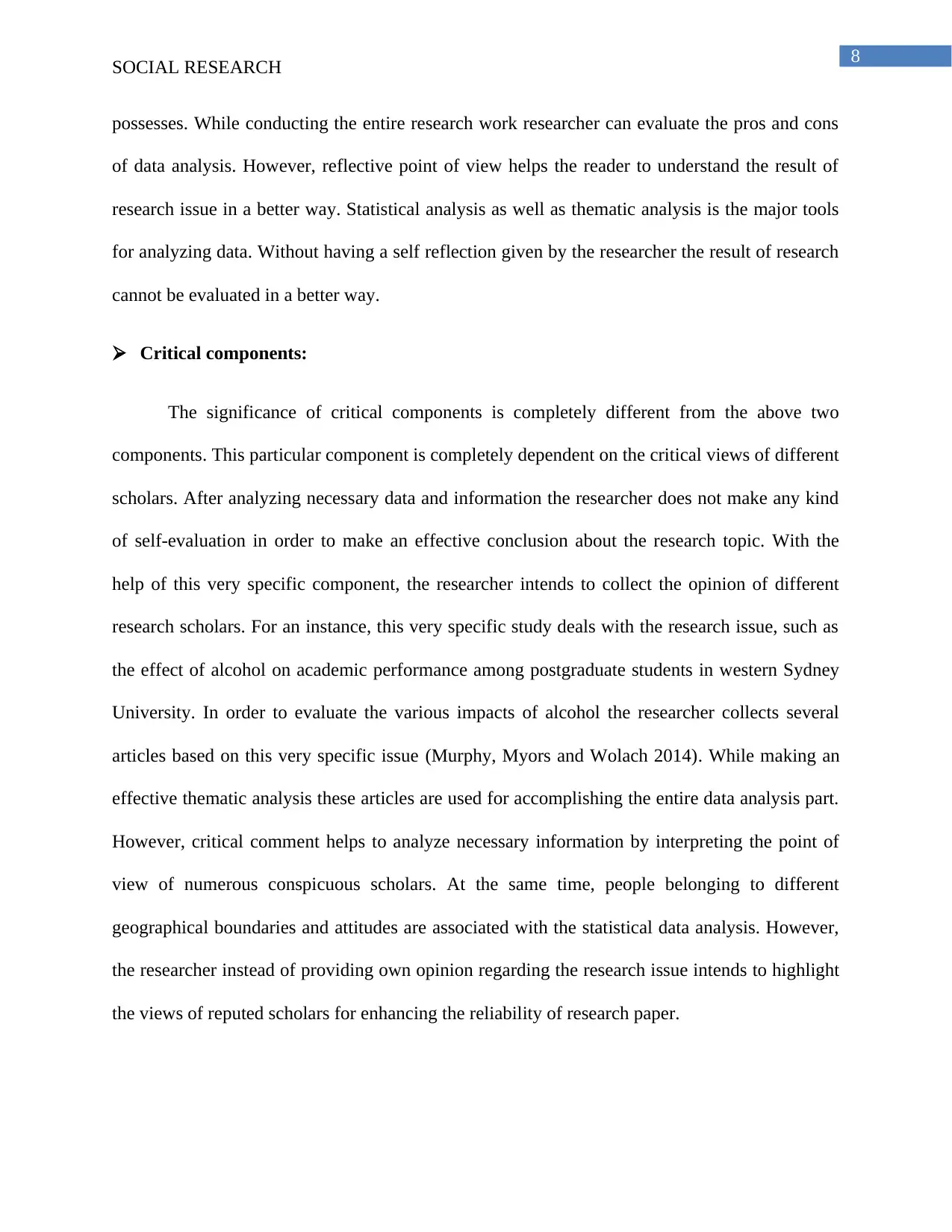
8
SOCIAL RESEARCH
possesses. While conducting the entire research work researcher can evaluate the pros and cons
of data analysis. However, reflective point of view helps the reader to understand the result of
research issue in a better way. Statistical analysis as well as thematic analysis is the major tools
for analyzing data. Without having a self reflection given by the researcher the result of research
cannot be evaluated in a better way.
Critical components:
The significance of critical components is completely different from the above two
components. This particular component is completely dependent on the critical views of different
scholars. After analyzing necessary data and information the researcher does not make any kind
of self-evaluation in order to make an effective conclusion about the research topic. With the
help of this very specific component, the researcher intends to collect the opinion of different
research scholars. For an instance, this very specific study deals with the research issue, such as
the effect of alcohol on academic performance among postgraduate students in western Sydney
University. In order to evaluate the various impacts of alcohol the researcher collects several
articles based on this very specific issue (Murphy, Myors and Wolach 2014). While making an
effective thematic analysis these articles are used for accomplishing the entire data analysis part.
However, critical comment helps to analyze necessary information by interpreting the point of
view of numerous conspicuous scholars. At the same time, people belonging to different
geographical boundaries and attitudes are associated with the statistical data analysis. However,
the researcher instead of providing own opinion regarding the research issue intends to highlight
the views of reputed scholars for enhancing the reliability of research paper.
SOCIAL RESEARCH
possesses. While conducting the entire research work researcher can evaluate the pros and cons
of data analysis. However, reflective point of view helps the reader to understand the result of
research issue in a better way. Statistical analysis as well as thematic analysis is the major tools
for analyzing data. Without having a self reflection given by the researcher the result of research
cannot be evaluated in a better way.
Critical components:
The significance of critical components is completely different from the above two
components. This particular component is completely dependent on the critical views of different
scholars. After analyzing necessary data and information the researcher does not make any kind
of self-evaluation in order to make an effective conclusion about the research topic. With the
help of this very specific component, the researcher intends to collect the opinion of different
research scholars. For an instance, this very specific study deals with the research issue, such as
the effect of alcohol on academic performance among postgraduate students in western Sydney
University. In order to evaluate the various impacts of alcohol the researcher collects several
articles based on this very specific issue (Murphy, Myors and Wolach 2014). While making an
effective thematic analysis these articles are used for accomplishing the entire data analysis part.
However, critical comment helps to analyze necessary information by interpreting the point of
view of numerous conspicuous scholars. At the same time, people belonging to different
geographical boundaries and attitudes are associated with the statistical data analysis. However,
the researcher instead of providing own opinion regarding the research issue intends to highlight
the views of reputed scholars for enhancing the reliability of research paper.
⊘ This is a preview!⊘
Do you want full access?
Subscribe today to unlock all pages.

Trusted by 1+ million students worldwide
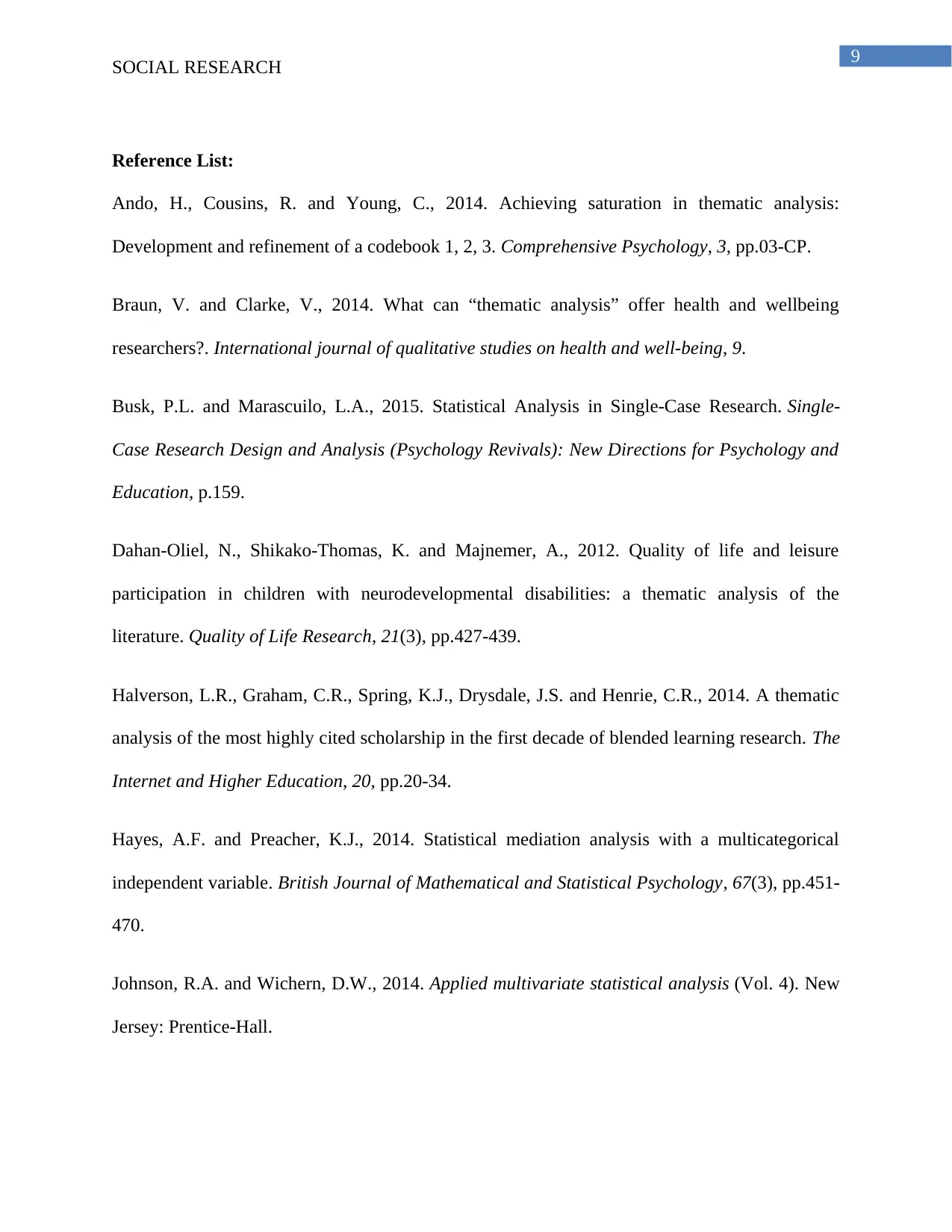
9
SOCIAL RESEARCH
Reference List:
Ando, H., Cousins, R. and Young, C., 2014. Achieving saturation in thematic analysis:
Development and refinement of a codebook 1, 2, 3. Comprehensive Psychology, 3, pp.03-CP.
Braun, V. and Clarke, V., 2014. What can “thematic analysis” offer health and wellbeing
researchers?. International journal of qualitative studies on health and well-being, 9.
Busk, P.L. and Marascuilo, L.A., 2015. Statistical Analysis in Single-Case Research. Single-
Case Research Design and Analysis (Psychology Revivals): New Directions for Psychology and
Education, p.159.
Dahan-Oliel, N., Shikako-Thomas, K. and Majnemer, A., 2012. Quality of life and leisure
participation in children with neurodevelopmental disabilities: a thematic analysis of the
literature. Quality of Life Research, 21(3), pp.427-439.
Halverson, L.R., Graham, C.R., Spring, K.J., Drysdale, J.S. and Henrie, C.R., 2014. A thematic
analysis of the most highly cited scholarship in the first decade of blended learning research. The
Internet and Higher Education, 20, pp.20-34.
Hayes, A.F. and Preacher, K.J., 2014. Statistical mediation analysis with a multicategorical
independent variable. British Journal of Mathematical and Statistical Psychology, 67(3), pp.451-
470.
Johnson, R.A. and Wichern, D.W., 2014. Applied multivariate statistical analysis (Vol. 4). New
Jersey: Prentice-Hall.
SOCIAL RESEARCH
Reference List:
Ando, H., Cousins, R. and Young, C., 2014. Achieving saturation in thematic analysis:
Development and refinement of a codebook 1, 2, 3. Comprehensive Psychology, 3, pp.03-CP.
Braun, V. and Clarke, V., 2014. What can “thematic analysis” offer health and wellbeing
researchers?. International journal of qualitative studies on health and well-being, 9.
Busk, P.L. and Marascuilo, L.A., 2015. Statistical Analysis in Single-Case Research. Single-
Case Research Design and Analysis (Psychology Revivals): New Directions for Psychology and
Education, p.159.
Dahan-Oliel, N., Shikako-Thomas, K. and Majnemer, A., 2012. Quality of life and leisure
participation in children with neurodevelopmental disabilities: a thematic analysis of the
literature. Quality of Life Research, 21(3), pp.427-439.
Halverson, L.R., Graham, C.R., Spring, K.J., Drysdale, J.S. and Henrie, C.R., 2014. A thematic
analysis of the most highly cited scholarship in the first decade of blended learning research. The
Internet and Higher Education, 20, pp.20-34.
Hayes, A.F. and Preacher, K.J., 2014. Statistical mediation analysis with a multicategorical
independent variable. British Journal of Mathematical and Statistical Psychology, 67(3), pp.451-
470.
Johnson, R.A. and Wichern, D.W., 2014. Applied multivariate statistical analysis (Vol. 4). New
Jersey: Prentice-Hall.
Paraphrase This Document
Need a fresh take? Get an instant paraphrase of this document with our AI Paraphraser
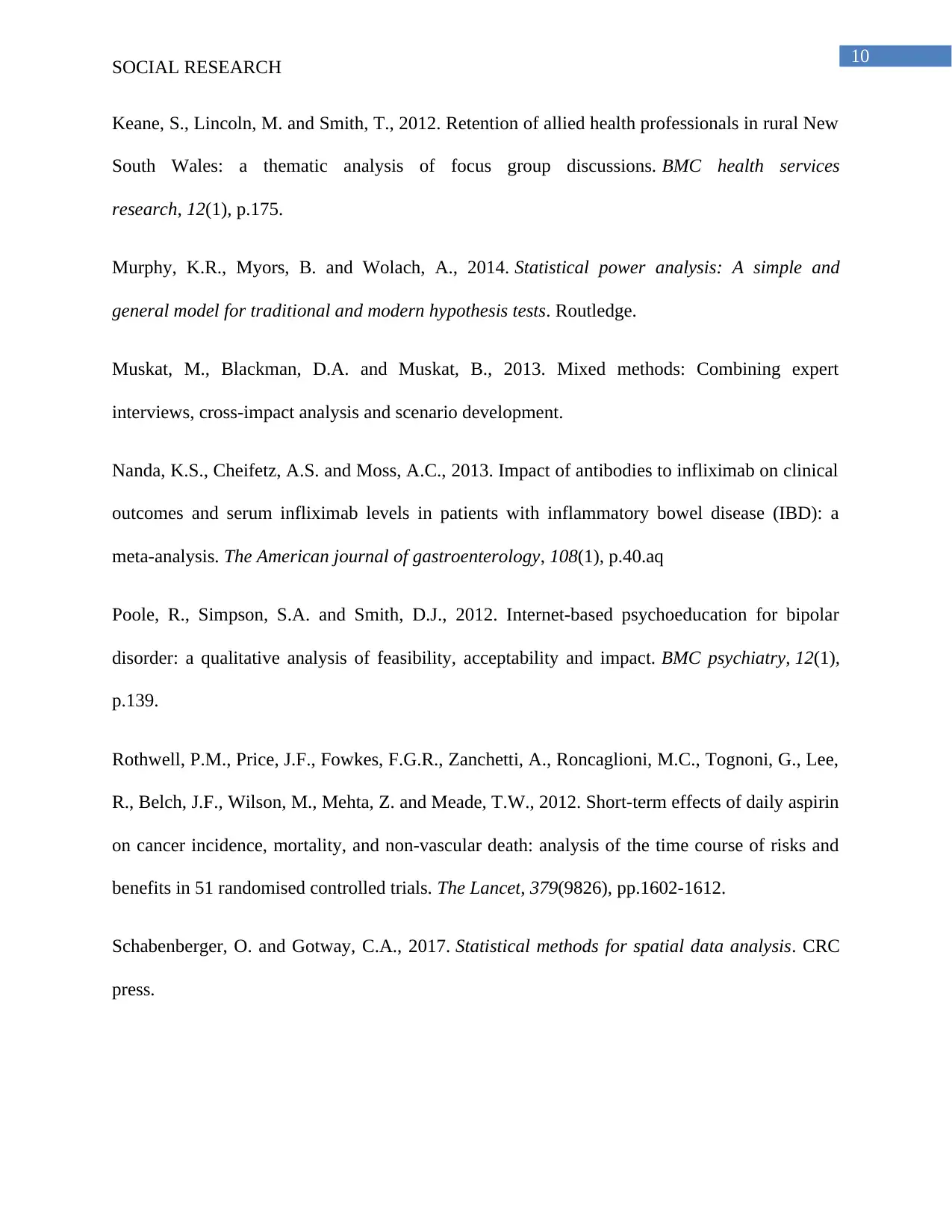
10
SOCIAL RESEARCH
Keane, S., Lincoln, M. and Smith, T., 2012. Retention of allied health professionals in rural New
South Wales: a thematic analysis of focus group discussions. BMC health services
research, 12(1), p.175.
Murphy, K.R., Myors, B. and Wolach, A., 2014. Statistical power analysis: A simple and
general model for traditional and modern hypothesis tests. Routledge.
Muskat, M., Blackman, D.A. and Muskat, B., 2013. Mixed methods: Combining expert
interviews, cross-impact analysis and scenario development.
Nanda, K.S., Cheifetz, A.S. and Moss, A.C., 2013. Impact of antibodies to infliximab on clinical
outcomes and serum infliximab levels in patients with inflammatory bowel disease (IBD): a
meta-analysis. The American journal of gastroenterology, 108(1), p.40.aq
Poole, R., Simpson, S.A. and Smith, D.J., 2012. Internet-based psychoeducation for bipolar
disorder: a qualitative analysis of feasibility, acceptability and impact. BMC psychiatry, 12(1),
p.139.
Rothwell, P.M., Price, J.F., Fowkes, F.G.R., Zanchetti, A., Roncaglioni, M.C., Tognoni, G., Lee,
R., Belch, J.F., Wilson, M., Mehta, Z. and Meade, T.W., 2012. Short-term effects of daily aspirin
on cancer incidence, mortality, and non-vascular death: analysis of the time course of risks and
benefits in 51 randomised controlled trials. The Lancet, 379(9826), pp.1602-1612.
Schabenberger, O. and Gotway, C.A., 2017. Statistical methods for spatial data analysis. CRC
press.
SOCIAL RESEARCH
Keane, S., Lincoln, M. and Smith, T., 2012. Retention of allied health professionals in rural New
South Wales: a thematic analysis of focus group discussions. BMC health services
research, 12(1), p.175.
Murphy, K.R., Myors, B. and Wolach, A., 2014. Statistical power analysis: A simple and
general model for traditional and modern hypothesis tests. Routledge.
Muskat, M., Blackman, D.A. and Muskat, B., 2013. Mixed methods: Combining expert
interviews, cross-impact analysis and scenario development.
Nanda, K.S., Cheifetz, A.S. and Moss, A.C., 2013. Impact of antibodies to infliximab on clinical
outcomes and serum infliximab levels in patients with inflammatory bowel disease (IBD): a
meta-analysis. The American journal of gastroenterology, 108(1), p.40.aq
Poole, R., Simpson, S.A. and Smith, D.J., 2012. Internet-based psychoeducation for bipolar
disorder: a qualitative analysis of feasibility, acceptability and impact. BMC psychiatry, 12(1),
p.139.
Rothwell, P.M., Price, J.F., Fowkes, F.G.R., Zanchetti, A., Roncaglioni, M.C., Tognoni, G., Lee,
R., Belch, J.F., Wilson, M., Mehta, Z. and Meade, T.W., 2012. Short-term effects of daily aspirin
on cancer incidence, mortality, and non-vascular death: analysis of the time course of risks and
benefits in 51 randomised controlled trials. The Lancet, 379(9826), pp.1602-1612.
Schabenberger, O. and Gotway, C.A., 2017. Statistical methods for spatial data analysis. CRC
press.
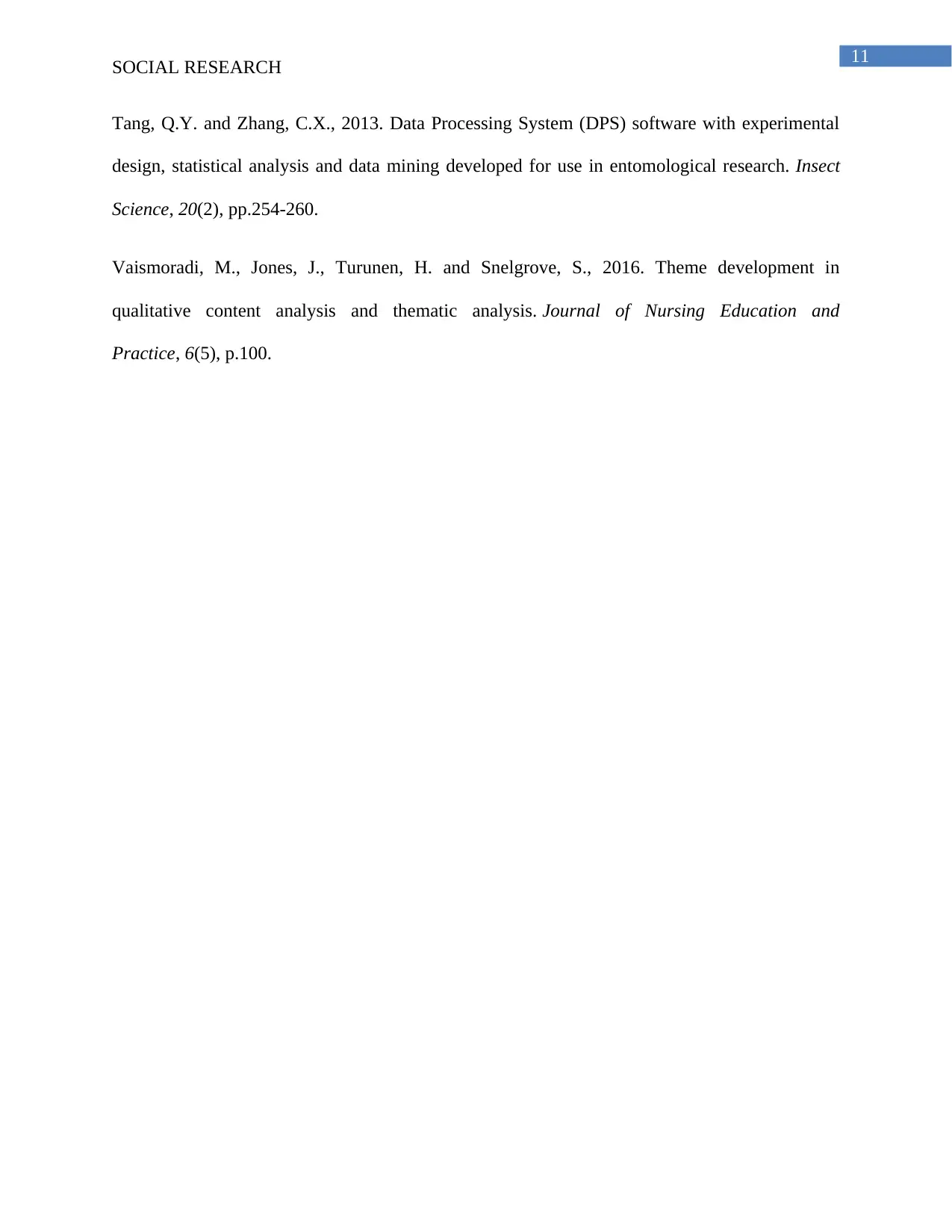
11
SOCIAL RESEARCH
Tang, Q.Y. and Zhang, C.X., 2013. Data Processing System (DPS) software with experimental
design, statistical analysis and data mining developed for use in entomological research. Insect
Science, 20(2), pp.254-260.
Vaismoradi, M., Jones, J., Turunen, H. and Snelgrove, S., 2016. Theme development in
qualitative content analysis and thematic analysis. Journal of Nursing Education and
Practice, 6(5), p.100.
SOCIAL RESEARCH
Tang, Q.Y. and Zhang, C.X., 2013. Data Processing System (DPS) software with experimental
design, statistical analysis and data mining developed for use in entomological research. Insect
Science, 20(2), pp.254-260.
Vaismoradi, M., Jones, J., Turunen, H. and Snelgrove, S., 2016. Theme development in
qualitative content analysis and thematic analysis. Journal of Nursing Education and
Practice, 6(5), p.100.
⊘ This is a preview!⊘
Do you want full access?
Subscribe today to unlock all pages.

Trusted by 1+ million students worldwide
1 out of 12
Related Documents
Your All-in-One AI-Powered Toolkit for Academic Success.
+13062052269
info@desklib.com
Available 24*7 on WhatsApp / Email
![[object Object]](/_next/static/media/star-bottom.7253800d.svg)
Unlock your academic potential
Copyright © 2020–2025 A2Z Services. All Rights Reserved. Developed and managed by ZUCOL.





